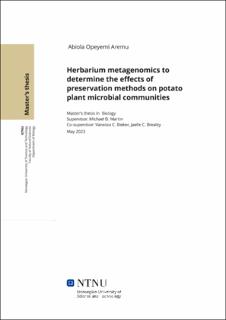| dc.description.abstract | Herbarium specimens are preserved plants kept for varying purposes, for example, botanical records, hobbies, referencing, research, economic and medicinal purposes. There are more than 3000 herbaria in the world that house approximately 350 million specimens from the last ca. 400 years. Due to advances in DNA extraction and next-generation sequencing (NGS) approaches, these specimens are now used for genetic studies and can be used to track genetic changes over time. Herbarium specimens do not only contain DNA from the plant itself, but also from associated microbes and pathogens that were present on the living plant and can thus be used to study the microbial community. However, due to different procedures they undergo during the process of preservation and storage of the specimens, herbarium specimens are also prone to microbial contamination.
In this project, plant samples were preserved with different methods including standard procedures for herbarium specimens preservation. Samples were taken at different steps of preservation in order to track changes in microbial abundance and identify possible contaminating microbial taxa. When these microbes are identified, herbarium specimens could be useful in carrying out metagenomic studies in the future. Two main potato (Solanum tuberosum) plant tissues (leaves and roots) were used for this project. Samples were collected from different individuals from two different farms in Trondheim. Samples were preserved at the Trondheim herbarium (TRH). Identification of the first 20 most abundant microbial taxa were done using a simple bar plot. Principal Coordinate Analysis (PCoA) was used to evaluate the similarities and variation between samples collected from different sites and preserved under varying conditions.
MaAslin 2.0 was used to identify whether changes in taxa abundance were significantly different between different preservation methods in the same plant tissue. Two genera were the most prominent in the plant tissues studied. No taxa abundance comparison is statistically significant in leaf samples while few microbial taxa have higher abundance in root samples upon comparisons. Alternaria alternata (common herbarium contaminant fungus) was not identified in any of the herbarium stored samples. We hypothesized that the absence of common herbarium contaminants could be due to high standards of modern herbarium practice at Trondheim Herbarium (TRH). Proper identification and removal of contaminants from herbarium specimens can help in making predictions about evolutionary trends of metagenomic communities on potato plants. | |
